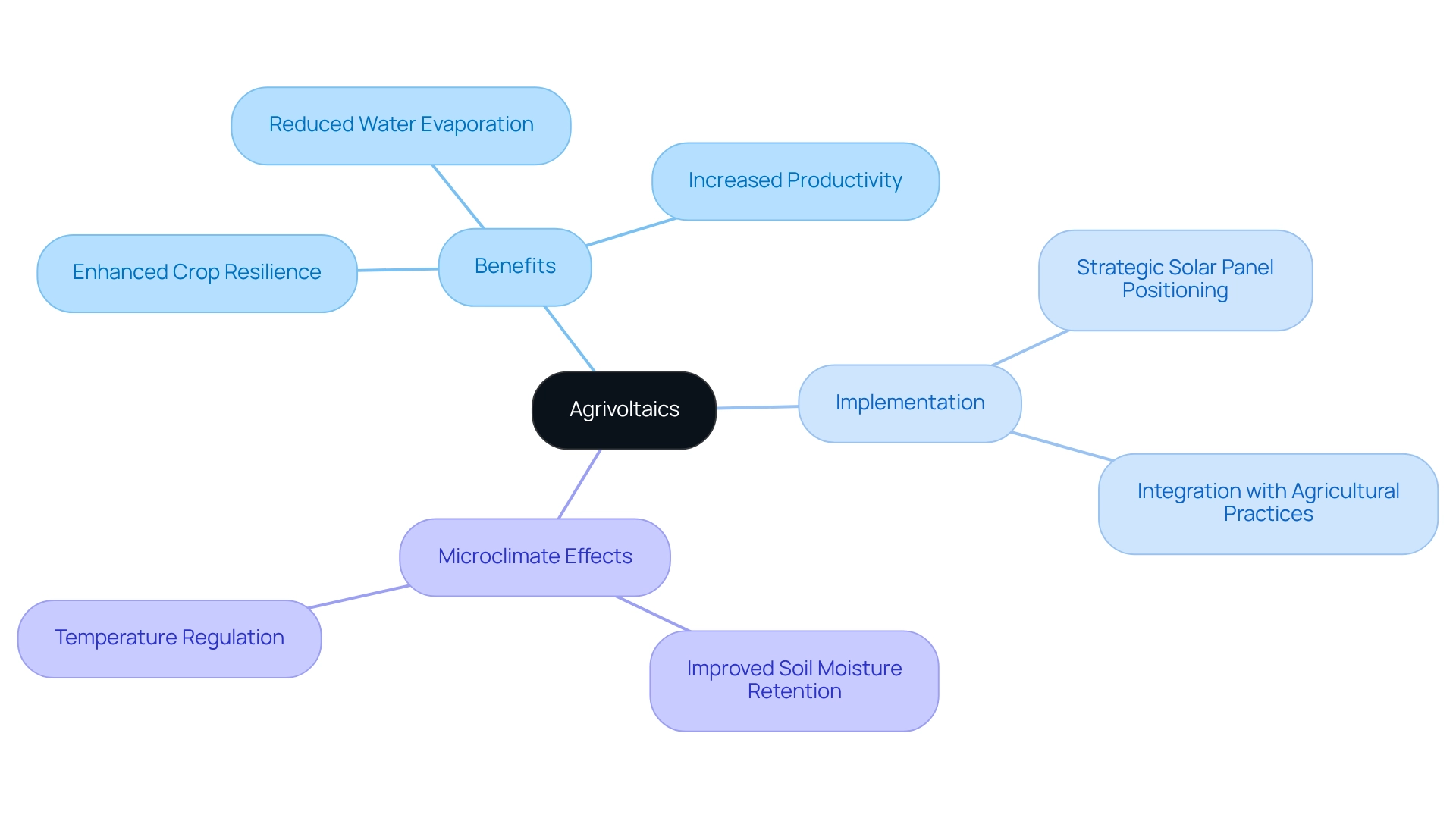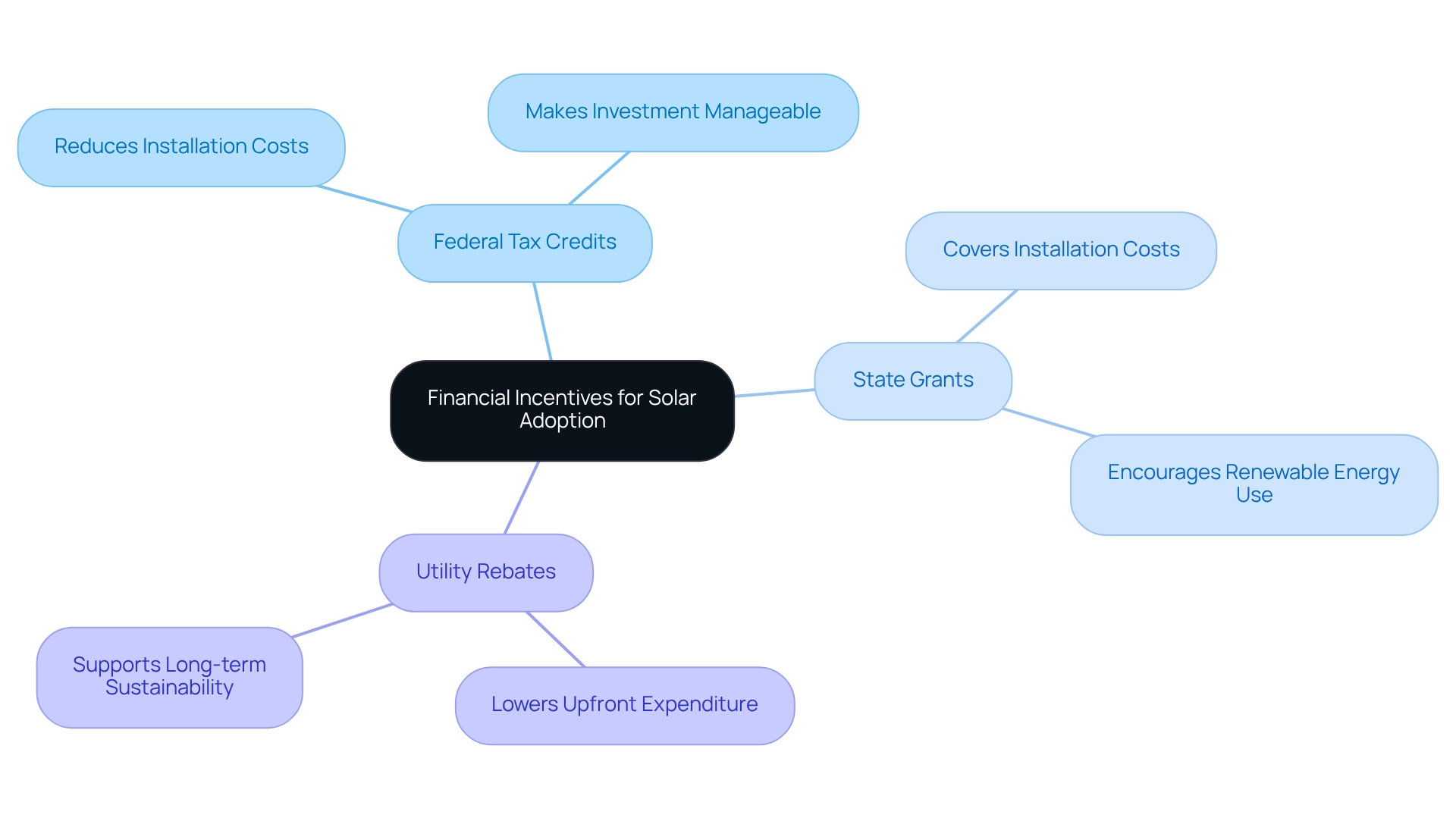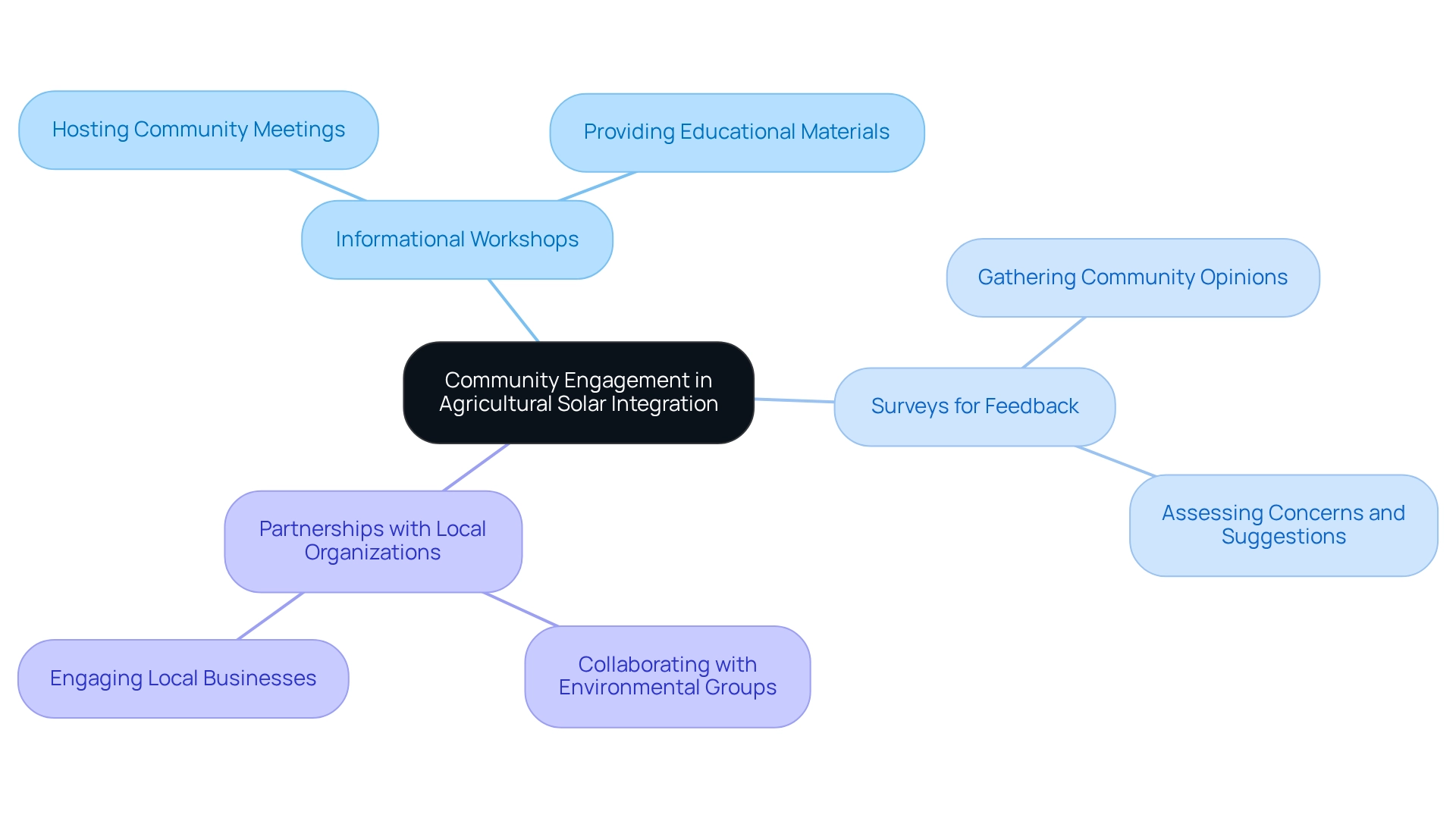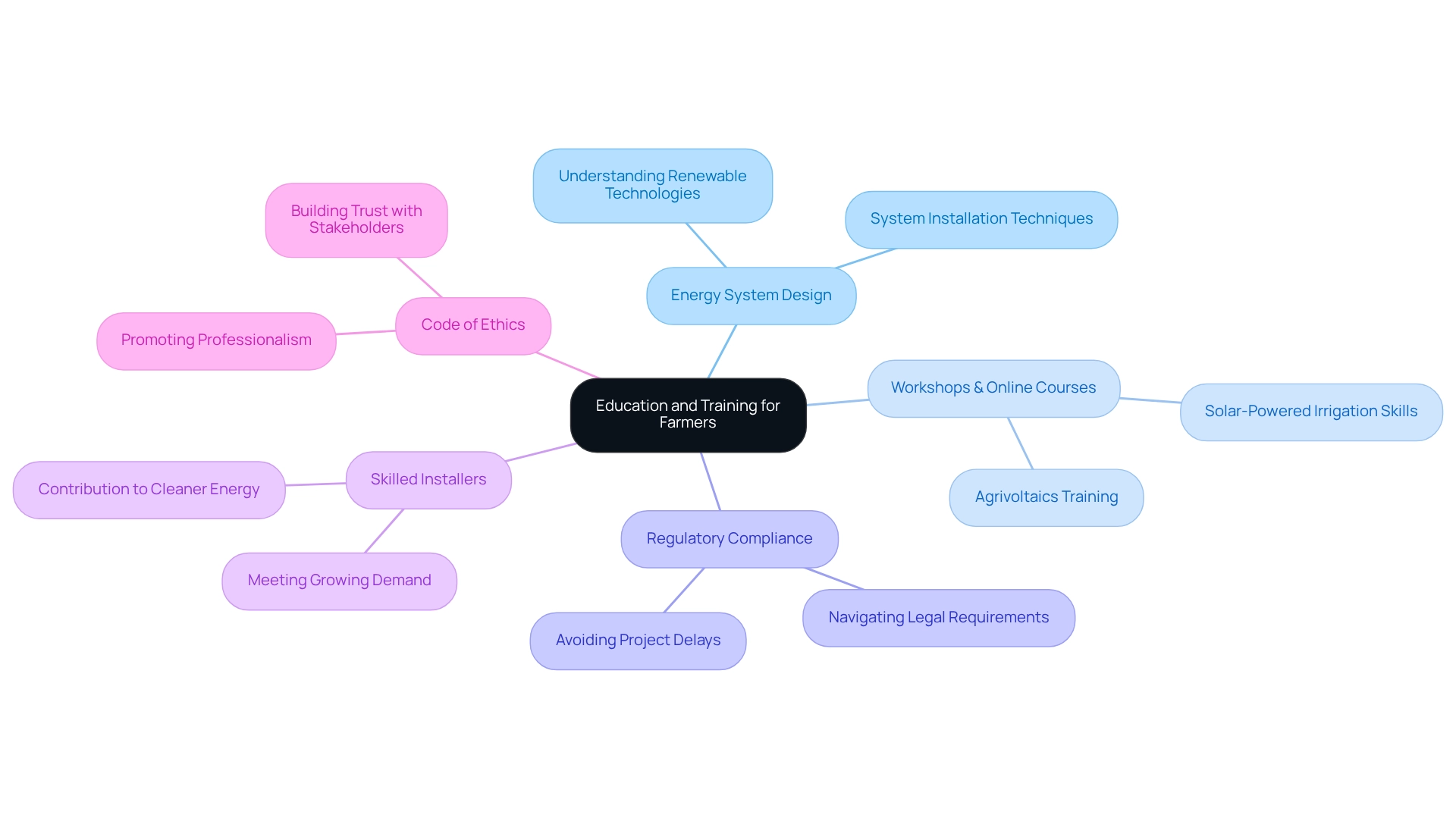Overview
The article emphasizes the critical strategies for implementing agricultural solar synergy plans, highlighting the integration of solar energy with agricultural practices to enhance productivity and sustainability. It delineates various approaches, such as:
- Agrivoltaics
- Solar-powered irrigation
- Financial incentives
These strategies demonstrate how farmers can optimize land use, reduce operational costs, and contribute to environmental sustainability. In doing so, they address the challenges faced in transitioning to renewable energy in agriculture.
Introduction
In an era where sustainability stands as a cornerstone of agricultural innovation, the integration of solar energy into farming practices is fundamentally reshaping the food production landscape. This article explores the diverse benefits of solar technologies, including:
- Agrivoltaics that enable crops to thrive beneath solar panels
- Solar-powered irrigation systems that optimize water management
As farmers confront escalating challenges such as climate change and resource scarcity, the transition to renewable energy solutions emerges as a vital pathway to resilience and efficiency. By emphasizing financial incentives, environmental benefits, and successful case studies, this exploration underscores how solar energy can transform agricultural practices and foster a sustainable future for the industry.
Harbinger Land | Comprehensive Solutions for Land Acquisition in Agricultural Solar Projects
Harbinger Land stands at the forefront of comprehensive solutions for land acquisition in agricultural solar synergy plans. Their services encompass site and right-of-way acquisition, title research, GIS mapping, and data processing—all meticulously designed to streamline the project lifecycle. By harnessing advanced technology, including AI-powered title research software and integrated GIS modeling services, Harbinger Land significantly enhances efficiency and client satisfaction. The firm's expert team excels in rapidly assembling large teams tailored to meet project requirements, ensuring that services are prompt and customized to the unique demands of clients in both the power and agriculture sectors.
As the renewable energy industry evolves, challenges such as interconnection limitations and labor availability remain prominent. Harbinger Land effectively addresses these challenges through strategic land acquisition practices, enabling projects to navigate these hurdles with confidence. The demand for photovoltaic energy continues to grow, with annual installation projections indicating potential expansion despite existing limitations. In 2024, community energy installations surged by 35%, underscoring the increasing interest in renewable solutions. Harbinger Land's strategic approach to land acquisition, supported by agricultural solar synergy plans and efficient document imaging solutions for title research and leasing, positions them as a key player in leveraging this trend, ensuring that farming energy projects can thrive in this dynamic environment. Furthermore, while the market is expanding, future capacity additions are anticipated to contract by an average of 8% annually through 2029. This reality underscores the critical nature of Harbinger Land's expertise in navigating these shifting market conditions.
Agrivoltaics: Maximizing Land Use Through Solar Energy Integration
Agrivoltaics, also known as agri-PV, represents a transformative approach to land use by implementing agricultural solar synergy plans that integrate photovoltaic systems with agricultural activities on the same parcel of land. This innovative strategy is part of agricultural solar synergy plans that empower farmers to generate renewable energy while simultaneously cultivating crops or raising livestock.
By strategically positioning solar panels above crops, farmers can foster a microclimate that enhances crop resilience, diminishes water evaporation, and boosts overall productivity. This dual-use method not only optimizes land utilization but also supports agricultural solar synergy plans, paving the way for a more resilient agricultural future.

Solar-Powered Irrigation: Revolutionizing Water Management in Agriculture
Solar-powered irrigation setups represent a revolutionary advancement in water management for farming, harnessing renewable sources to operate water pumps. This innovation significantly reduces dependence on fossil fuels, resulting in considerable operational cost savings for farmers. Particularly advantageous in remote regions lacking conventional energy sources, these systems ensure a reliable water supply for crops, enhancing irrigation efficiency and promoting sustainable farming practices. Furthermore, by utilizing renewable energy, farmers contribute meaningfully to mitigating climate change, as these technologies markedly decrease greenhouse gas emissions compared to traditional irrigation methods.
Recent data indicates a growing trend in the adoption of solar-powered irrigation solutions, with many farmers reporting cost savings and improved crop yields. For example, a notable case study from the Gonglaoping community illustrates their collaboration with various stakeholders to advocate for sustainable practices, showcasing successful implementations of solar irrigation that have positively influenced water management and agricultural productivity. Agricultural engineers assert that these frameworks not only optimize water use but also empower farmers to manage resources more effectively, particularly in areas facing water scarcity.
The Gonglaoping Industrial Development Association has recently finalized and secured approval for its rural regeneration plan, which encompasses initiatives for solar-powered irrigation systems. This community engagement exemplifies the potential of renewable resources to enhance sustainability in agriculture. As the agricultural sector increasingly embraces renewable energy solutions, agricultural solar synergy plans, including solar-powered irrigation, emerge as a pivotal strategy for advancing sustainability and resilience in farming practices.
Financial Incentives: Boosting Solar Adoption in Agricultural Practices
Farmers have a significant opportunity to enhance their operations through various financial incentives designed to promote the adoption of renewable energy technologies. These incentives include:
- Federal tax credits
- State grants
- Utility rebates
All aimed at alleviating the financial burden associated with the transition to renewable energy.
The Federal Investment Tax Credit (ITC) allows farmers to deduct a substantial portion of their installation expenses from their federal taxes, making the initial investment more manageable. In addition, numerous states have implemented targeted initiatives that encourage the use of renewable energy in agriculture, often covering a portion of installation costs. Such financial support not only reduces the upfront expenditure required for renewable energy systems but also strengthens the long-term economic sustainability of farming operations.
By taking advantage of these financial incentives, farmers can not only lower their initial costs but also position themselves for greater resilience and profitability in a rapidly evolving energy landscape. It is essential for farmers to explore these opportunities to ensure they are not left behind in the transition to sustainable practices.

Environmental Benefits: Enhancing Sustainability Through Solar Energy in Agriculture
Incorporating renewable power into farming methods presents significant ecological advantages. Solar farms play a crucial role in reducing greenhouse gas emissions by substituting fossil fuel-based power sources. Additionally, the shade provided by photovoltaic panels lowers soil temperatures, minimizes water evaporation, and enhances crop resilience against severe weather conditions. By promoting biodiversity and enhancing soil vitality, renewable power systems contribute to more sustainable farming practices. This ultimately leads to healthier ecosystems and increased crop productivity, showcasing the transformative potential of renewable energy in agriculture.
Case Studies: Successful Integration of Solar Energy in Farming
Numerous case studies illustrate the successful integration of sunlight power in farming, showcasing its dual benefits for agricultural productivity and renewable energy generation. For instance, a vineyard in California has effectively implemented agrivoltaics by installing solar panels above grapevines. This innovative approach not only increased power production but also improved grape quality by reducing heat stress. Similarly, a dairy farm adopted solar-powered irrigation solutions, which significantly decreased water expenses and enhanced crop yields.
These examples underscore the potential of sunlight power to transform agricultural practices, suggesting that agricultural solar synergy plans could fulfill the entire electricity demands of the farming sector by unlocking just 9% of agrivoltaic capacity. Historically, Japan pioneered 'sunlight sharing' systems in 2004, merging renewable energy generation with various food crops, establishing a global benchmark for agrivoltaics.
As the USA begins to explore agricultural solar synergy plans, exemplified by a small-scale research facility established in Arizona at the Biosphere 2 research center, the outlook for sustainable farming methods utilizing solar power appears promising. This research facility signifies the onset of agrovoltaic development in North America, potentially leading to wider adoption of this sustainable practice.
Moreover, the introduction of agricultural solar synergy plans in Central Europe reflects the increasing recognition of this approach, paving the way for broader acceptance and success across diverse agricultural sectors. As Inemesit Ukpanah aptly states, "Incorporating this method into agricultural practices can help ensure a sustainable future for food production and power supply.
Future Innovations: Advancements in Solar Technology for Agriculture
The future of photovoltaic technology in agriculture is set to revolutionize the sector, driven by significant advancements such as bifacial panels, which effectively capture sunlight from both sides, thus enhancing power efficiency. Agrivoltaics are a key example of agricultural solar synergy plans, as they not only reduce the carbon footprint associated with traditional farming and power generation but also optimize land use by allowing agriculture and sunlight harvesting to coexist.
Floating photovoltaic farms are emerging as a viable solution, leveraging water bodies to generate clean power while minimizing land use. Furthermore, advancements in power storage solutions are vital, enabling farmers to retain excess power for use during peak demand periods, thereby improving power resilience.
Intelligent irrigation systems powered by sunlight are also gaining traction, improving water usage and advancing crop management. These technologies contribute to sustainable agricultural practices and significantly lower the carbon footprint linked to conventional farming methods.
As Tamesol wisely states, "Together, we can embrace the future of renewable power and drive the transition to a cleaner, greener world, fostering a legacy of sustainability for generations to come."
As the sector continues to evolve, ongoing investment in research and development will be essential to unlock the full potential of these energy innovations, ensuring that agriculture can meet the challenges of a changing climate while promoting environmental stewardship.
Community Engagement: Collaborating for Successful Solar Integration in Agriculture
Community involvement is crucial for effectively incorporating agricultural solar synergy plans in renewable energy within agriculture. Engaging local stakeholders—farmers, community leaders, and environmental organizations—in agricultural solar synergy plans addresses concerns and cultivates support for renewable energy initiatives. Strategies that prove effective include:
- Hosting informational workshops
- Conducting surveys to gather feedback
- Establishing partnerships with local organizations
By promoting open communication and teamwork, developers can create projects that resonate with community values and priorities, ultimately leading to more successful outcomes.

Challenges and Solutions: Overcoming Barriers to Solar Adoption in Agriculture
Farmers encounter significant challenges in implementing renewable energy technologies, including high initial costs, complex regulatory hurdles, and concerns regarding land use. Addressing these barriers is essential for fostering the integration of renewable energy in agriculture. Financial incentives and grants can substantially lower upfront costs, making investments in renewable energy more feasible. Moreover, streamlining the permitting process is critical; a simplified approach can empower farmers to navigate regulatory requirements more effectively. Customized learning materials for farming stakeholders can clarify energy technologies and their benefits.
Engaging with local communities is crucial to addressing land use concerns. As Brian Ross notes, "the main perceived conflict is between farming applications and energy uses," highlighting the tradeoff between the economic foundation of farming and the growing renewable industry. By showcasing the benefits of renewable integration—such as increased autonomy and potential income sources—farmers can cultivate community support. Research shows that larger installations, like photovoltaic pumps, often yield superior economic performance compared to smaller systems, underscoring the importance of tailored solutions for various agricultural segments. The absence of relevant and customized products for different farmer segments hampers market growth, further emphasizing the need for targeted approaches.
As the renewable energy sector in the U.S. continues to grow, with an impressive 25% year-on-year increase and surpassing 200 gigawatts of capacity, it is vital to develop effective strategies that tackle regulatory challenges. Information regarding the regulatory obstacles faced by farmers utilizing renewable energy reveals significant barriers that must be addressed. Expert opinions stress the need for collaboration between the farming and renewable energy sectors to establish a sustainable future that benefits both industries. By overcoming these challenges, the agricultural community can fully harness the potential of renewable technologies, paving the way for a more sustainable and economically viable agricultural landscape.
Education and Training: Empowering Farmers for Solar Synergy Success
Education and training are pivotal in equipping farmers to seamlessly integrate renewable technologies into their operations. Comprehensive programs that cover energy system design, installation, and maintenance empower farmers with a clear understanding of the benefits and practical applications of renewable energy. Workshops and online courses centered on agrivoltaics and solar-powered irrigation are particularly beneficial, as they provide essential hands-on skills for optimizing agricultural practices. In 2025, a multitude of workshops will be conducted to enhance farmers' understanding of renewable energy technologies, ensuring they are adequately prepared to adopt these innovations.
Furthermore, compliance with regulations is crucial to avoid legal complications and project delays within the energy sector, underscoring the necessity for education in navigating these regulations. Successful initiatives have demonstrated that skilled installers significantly contribute to a cleaner energy future, fostering a more sustainable agricultural landscape. The establishment of a competent workforce through training initiatives is vital to meet the growing demand for renewable energy systems, further emphasizing the importance of these educational endeavors.
Additionally, adherence to a code of ethics in solar certification programs cultivates professionalism and integrity within the industry, building trust among clients and stakeholders. By prioritizing education and training, farmers not only enhance their productivity but also play a vital role in the transition to renewable energy solutions.

Conclusion
The integration of solar energy into agricultural practices presents a transformative opportunity for the farming sector, effectively addressing both environmental and economic challenges. Innovative approaches such as agrivoltaics and solar-powered irrigation systems enable farmers to maximize land use while enhancing crop resilience and water management. These technologies not only reduce operational costs and reliance on fossil fuels but also contribute to sustainable farming practices that are increasingly essential in the face of climate change.
Financial incentives are crucial in encouraging the adoption of solar technologies, empowering farmers to invest in systems that promise long-term benefits. The environmental advantages of solar energy—ranging from reducing greenhouse gas emissions to improving soil health—further underscore its importance in creating a more sustainable agricultural landscape. Successful case studies illustrate how solar integration can lead to improved productivity and energy independence, paving the way for a resilient future.
Looking ahead, ongoing innovations in solar technology and community engagement will be vital in overcoming barriers to adoption. By providing education and training, stakeholders can empower farmers to harness the full potential of solar energy, ensuring that agricultural practices not only thrive but also contribute positively to the environment. As the agricultural sector embraces these renewable solutions, it stands poised to redefine food production and energy supply for a sustainable future.
Frequently Asked Questions
What services does Harbinger Land provide for land acquisition in agricultural solar synergy plans?
Harbinger Land offers site and right-of-way acquisition, title research, GIS mapping, and data processing, all designed to streamline the project lifecycle.
How does Harbinger Land enhance efficiency in their services?
They utilize advanced technology, including AI-powered title research software and integrated GIS modeling services, which significantly improves efficiency and client satisfaction.
What challenges in the renewable energy industry does Harbinger Land address?
Harbinger Land addresses challenges such as interconnection limitations and labor availability through strategic land acquisition practices.
What is the significance of agrivoltaics in agricultural practices?
Agrivoltaics, or agri-PV, integrates photovoltaic systems with agricultural activities, allowing farmers to generate renewable energy while cultivating crops or raising livestock, optimizing land use and enhancing productivity.
How do solar-powered irrigation systems benefit farmers?
These systems reduce dependence on fossil fuels, lower operational costs, ensure a reliable water supply, enhance irrigation efficiency, and contribute to mitigating climate change by decreasing greenhouse gas emissions.
What recent trends have been observed in the adoption of solar-powered irrigation solutions?
There is a growing trend in the adoption of these solutions, with many farmers reporting cost savings and improved crop yields, as demonstrated by successful case studies like that of the Gonglaoping community.
How does Harbinger Land position itself in the evolving renewable energy market?
Harbinger Land's strategic approach to land acquisition, supported by agricultural solar synergy plans, positions them as a key player in leveraging the growing demand for photovoltaic energy and addressing market challenges.
List of Sources
- Harbinger Land | Comprehensive Solutions for Land Acquisition in Agricultural Solar Projects
- Solar Market Insight Report Q4 2024 – SEIA (https://seia.org/research-resources/solar-market-insight-report-q4-2024)
- fb.org (https://fb.org/market-intel/solar-energy-expansion-and-its-impacts-on-rural-communities)
- css.umich.edu (https://css.umich.edu/publications/factsheets/energy/us-renewable-energy-factsheet)
- Solar Market Insight Report 2024 Year in Review – SEIA (https://seia.org/research-resources/solar-market-insight-report-2024-year-in-review)
- Solar-Powered Irrigation: Revolutionizing Water Management in Agriculture
- Sustainable Rural Development and Water Resources Management on a Hilly Landscape: A Case Study of Gonglaoping Community, Taichung, ROC (Chinese Taipei) (SITR6-7) - The International Partnership for the Satoyama Initiative (IPSI) (https://satoyamainitiative.org/case_studies/sustainable-rural-development-and-water-resources-management-on-a-hilly-landscape-a-case-study-of-gonglaoping-community-taichung-roc-chinese-taipei-sitr6-7)
- Case Studies: Successful Integration of Solar Energy in Farming
- Agrovoltaics: Solar Energy for Sustainable Farming (https://greenmatch.co.uk/blog/agrovoltaics-solar-energy-for-sustainable-farming)
- Empowering farmers in Central Europe: the case for agri-PV | Ember (https://ember-energy.org/latest-insights/empowering-farmers-in-central-europe-the-case-for-agri-pv)
- Future Innovations: Advancements in Solar Technology for Agriculture
- Revolutionary Solar Technologies Set to Dominate in 2025 | Tamesol (https://tamesol.com/emerging-solar-technologies-2025)
- Solar farming key to future agriculture | Pennsylvania Ag Connection (https://pennsylvaniaagconnection.com/news/solar-farming-key-to-future-agriculture)
- Best 10 Game-Changing Solar Energy: A Comprehensive Guide (https://soleosenergy.com/10-game-changing-solar-energy-trends-in-2025)
- Challenges and Solutions: Overcoming Barriers to Solar Adoption in Agriculture
- Top 10 Inspiring Quotes About Solar Energy - Solar academy (https://solar-academy.com/top-10-inspiring-quotes-about-solar-energy)
- Barriers to the uptake of solar-powered irrigation by smallholder farmers in sub-saharan Africa: A review (https://sciencedirect.com/science/article/pii/S2211467X24000014)
- Solar Plus: How Solar-Integrated Agriculture Could Reduce Barriers to Large-Scale Solar Deployment (https://betterenergy.org/blog/solar-plus-how-solar-integrated-agriculture-could-reduce-barriers-to-large-scale-solar-deployment)
- Education and Training: Empowering Farmers for Solar Synergy Success
- Empowering Solar Installers: Advancing Skills through Training and Certification (https://arka360.com/ros/solar-training-certification-advancing-skills)




